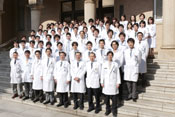Keiichi Fukuda, Professor, School of Medicine
Aiming for the pathophysiological explanation and therapy of heart disease with leading edge science
Field of expertise is cardiology. Treats patients with myocardial infarction, valvular heart disease, arrhythmia and heart failure applying the latest technology as well as uncovers the cause of these diseases at the molecular level. 23 graduate school students are enrolled.

The heart is an organ with a function of pumping blood from the veins to the arteries. About 28 years ago when I became a doctor, the heart as a function of a pump was understood, but the reason of heart disease was still uncovered and elucidating the cause of heart disease at the molecular level was not possible. However, an outstanding progress has been made in the last 20 years, and today, many of the unexplained diseases are now uncovered, and clues to start treatment are now being found.
It was my childhood dream to become a scientist, and after joining the School of Medicine, I have always aimed to uncover the cause of a disease and to come up with a new treatment method. The research to regenerate muscles of the heart that I started 16 years ago hoping to save lives of patients with heart failure was just like a fantasy in those days. I started regenerating heart muscles using stem cells obtained from bone marrow, but the development of human embryonic stem cells and discovery of iPS cells have accelerated research towards clinical application. And today, this has developed to become the world’s trend. Also, my research on how valvular heart disease is caused and how it develops and findings that during heart failure, the cardiac sympathetic nervous system transdifferentiates into the parasympathetic nervous system have developed to research that surprised the world’s cardiologists and researchers.
Today, many young people who empathize with my efforts have gathered in my laboratory, and almost 80 people including doctors, graduate students, international students, research assistants and clinical research coordinators work together. I hope to bring together young people’s strength and make a better laboratory as a place for human development, and further more, redefine science as the true meaning of “practical learning” or Jitsugaku, indicated by Yukichi Fukuzawa, so that we can realize Keio medicine that leads the world.
Student's Voice
Tomohisa Seki, Third-year Student of Doctoral Program,
Graduate School of Medicine (at the time of writing)
*Have completed course within 3 years in March 2011. Standard number of years for course completion is 4 years.
Research that helps patients in the forefront
After completing my initial clinical training, I started to study as a graduate students of cardiovascular internal medicine under guidance of Professor Keiichi Fukuda, and I carried out research to find a method for generation of iPS cells that is less-invasive for patients. I established a method for generation of iPS cells from a small amount of blood, and published my paper in a science journal called Cell Stem Cell. I was then awarded the first Ikushi Prize of Japan Society for the Promotion of Science. Each step that is made in the laboratory is aimed at producing results that help patients in the forefront of clinical therapy. I received high-level and highly motivated guidance for my research, and I feel lucky to have been able to study in such a favorable environment.
*Position titles, etc., are those at the time of publishing.
